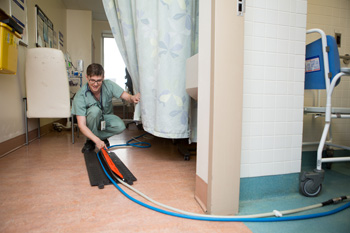Physiotherapist’s invention sets patients free

By Emily Holton

Physiotherapist Ian Barrett prepares to help his patient safely cross a neighbour’s dialysis lines. (Photo by Yuri Markarov)
When physiotherapist Ian Barrett sees a problem, he sees a project. That’s why, when he spotted a falls risk in Nephrology/Urology, he made it his mission to fix it properly.
Many of Barrett’s patients receive dialysis, which requires a machine with a water line to be hooked up to a tap and sink. In a shared inpatient room, this means a spaghetti trail of quarter-inch tubes will often cross a neighbouring patient’s area.
“Whether they’re loose or taped down, tubes across the floor would be a falls risk for anyone,” explained Barrett. “But if someone is using a walker or wheelchair, they’re basically trapped. They can’t go for therapy and we set them up with a commode because they can’t even get to the bathroom for several hours. My job is to get people up and moving, so I really wanted to find a solution.”
On his morning commute, Barrett noticed a heavy-duty cable ramp in a construction area. He consulted with colleagues and his manager, and then his search began for the ideal cable ramp for the unit. It had to be light weight, to make it easy to carry from room to room. It needed a shallow gradient to be easy to cross – but not so shallow that the width created excess weight. The ramp also had to be short enough to be used in tight spaces, but longer than the wheel base of a walker or wheelchair.
Barrett found an option that seemed like the best of all worlds. However when the ramp arrived, he realized there was another, equally important requirement: stability.
“With the weight of a truck driving over it, I’m sure it would work fine,” said Barrett. “But when I tested it with water lines pulling or one person pushing an IV pole across, the ramp skated across our smooth floors.”
“I love being a physio because when I help solve mobility problems for patients, I’m improving their quality of life.” – Ian Barrett |
He needed something to make the base of the ramp stickier, but it had to meet the hospital’s strict infection-control criteria. Anything used in an inpatient room has to be frequently cleaned and disinfected.
The solution was right under his nose.
Physiotherapists use Dycem self-adhesive strips to help patients grip surfaces such as wheelchair arms, walker handles and cutlery. Dycem is flexible, can be cut to size and most importantly, Barrett already knew exactly how to adhere and clean it.
It worked. Today, Barrett is working with Environmental Services to perfect his cleaning technique – he wants to make sure the products he uses don’t degrade the ramp’s plastic over time. Next, he’s planning to train more staff to safely use and disinfect it.
The appeal of problem solving is what drew Barrett to physiotherapy.
“I love being a physio because when I help solve mobility problems for patients, I’m improving their quality of life,” said Barrett. “I never have to question why I’m coming to work in the morning.”
About St. Michael’s Hospital
St. Michael’s Hospital provides compassionate care to all who enter its doors. The hospital also provides outstanding medical education to future health care professionals in more than 29 academic disciplines. Critical care and trauma, heart disease, neurosurgery, diabetes, cancer care, care of the homeless and global health are among the Hospital’s recognized areas of expertise. Through the Keenan Research Centre and the Li Ka Shing International Healthcare Education Centre, which make up the Li Ka Shing Knowledge Institute, research and education at St. Michael’s Hospital are recognized and make an impact around the world. Founded in 1892, the hospital is fully affiliated with the University of Toronto.
